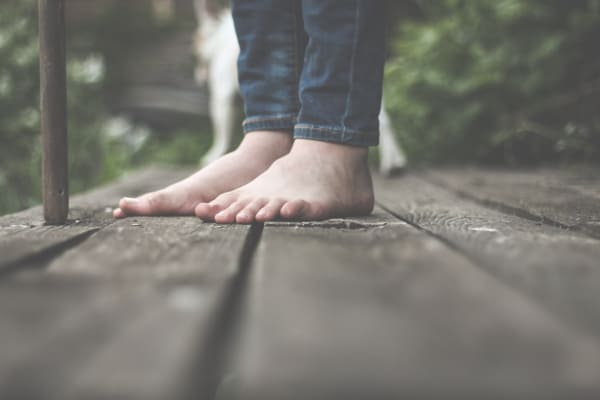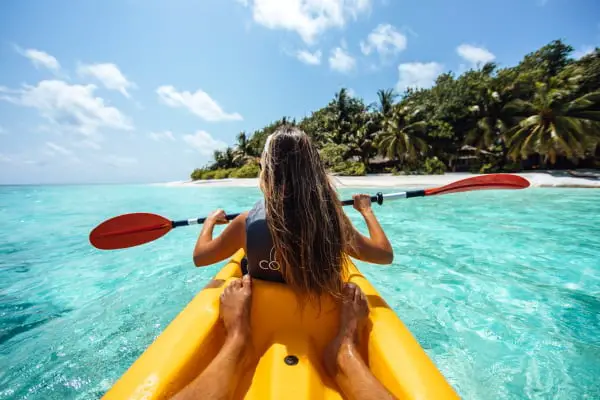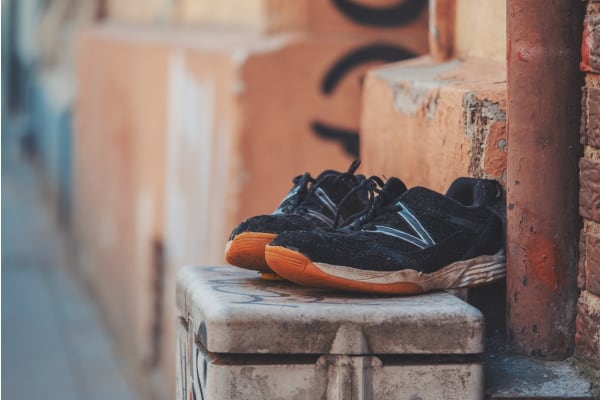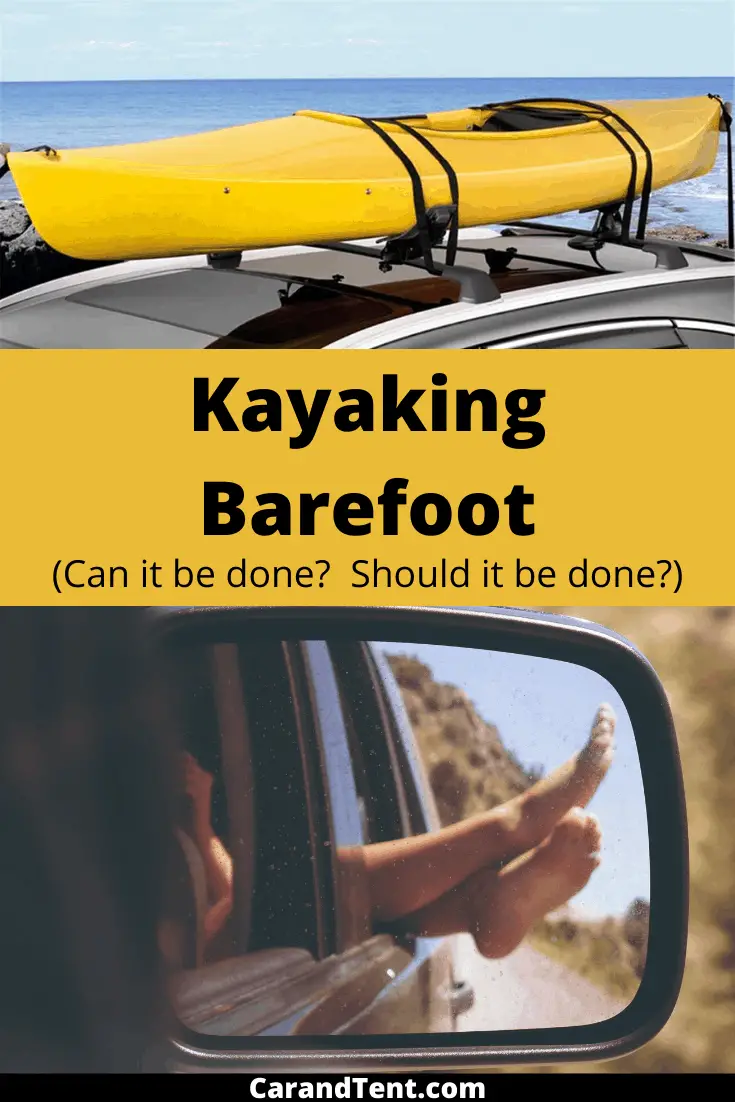
Kayaking can be simple and it can be hard. It can be safe and it can be dangerous.
The variables change dramatically based on when and where a person decides to go kayaking. For people just getting into kayaking, this can create a lot of questions with a lot of different answers.
One question a lot of people ask is can I go kayaking barefoot? People can go kayaking barefoot and in certain circumstances, it may even be better to go kayaking barefoot. In other situations, it’s better to wear shoes or sandals.
For a simple determination of whether or not you should wear shoes when kayaking or go barefoot, consider the details of your trip. Will you be kayaking in a place where walking to the launch site does not require footwear? Are you ok with not having shoes on if you happen to fall into shallow water? Is there a chance you’ll land your kayak someplace that might require you to have shoes?
Think about these questions hard before you decide to go kayaking barefoot.
In the rest of this post, I’ll give you the rundown on when and where I go barefoot kayaking and I’ll give you some tips on choosing kayaking footwear.
Table of Contents
Places to Wear Shoes or Sandals When Kayaking
There are a few places where I won’t even consider kayaking barefoot. These are:
- Places I have to carry my kayak to.
- Places where I may get out of the kayak in a different area than where I launched it.
- Any wooded area.
- Shallow rivers, streams, and lakes.
Porting a Kayak Barefoot
Anytime I have to carry my kayak down to a launch area is a time that I do not go kayaking without something on my feet. It just doesn’t make sense to walk through areas of hot pavement, hot sand, or gravel just to have the luxury of kayaking without shoes.
Even in areas where you’ll just be porting your kayak through dirt or grass might be an area where you should wear your shoes. A good pair of water shoes or sandals will keep you from accidentally walking through duck feces or from simply stubbing your toes on the way down to the launch area.
Unexplored Landing Sites
Sometimes I like to pull my kayak off the lake or river to go exploring. Other times I have to pull off so that I can answer the call of nature.
Either way, I won’t know whether or not the area is safe for walking through until I get there. Having my kayaking shoes or sandals on ensures that regardless of what the area looks like, I’ll still be able to safely step out my kayak without hurting my feet.
Wooded Areas
I used to think it was obvious that you shouldn’t walk through the woods without some type of footwear but then I watched Dual Survival. Don’t end up like Cody Lundin, (see the video below). Wear a good pair of shoes or sandals anytime you have to port your kayak through the woods.
Shallow Rivers Streams and Lakes

Places to Go Kayaking Barefoot
The only place that I ever go kayaking barefoot is at the beach. I’ll wear a pair of sandals down to the beach and I’ll leave them on land with my towel and my cooler.
My thought process is that I normally swim in the water without my shoes so I know I’ll be able to walk into the water without them with my kayak. Once I’m offshore, I’ll be deep enough that I won’t be able to stand anyway.
Leaving my sandals behind while ocean kayaking is liberating and it makes the experience a little more comfortable. This being said, if I ever go ocean kayaking on a beach with a lot of broken shells or rocks, I wouldn’t hesitate to put a pair of water shoes or sandals back on.

Kayaking Footwear
Since it should be obvious by now that there aren’t a lot of places where you can go kayaking without some sort of footwear, let’s go over your options. In my experience, there are really only two viable footwear options for kayaking. The first is a pair of water shoes and the second is a pair of sandals.
Water Shoes for Kayaking
Some might wonder, why not just wear old running shoes when kayaking? There are a few good reasons for this.
For starters, once a pair of regular shoes gets wet they become very heavy. This could make getting back into your kayak a little more difficult than it has to be.
Another reason is that running shoes aren’t going to dry out quickly. This means once you get them wet, they’ll stay wet throughout the rest of your trip. They’ll be uncomfortable and if you end up having to walk in them, you’ll probably end up with blisters.
Lastly, once your old shoes get wet, they are going to smell terrible. I don’t know about you, but I just can’t stand the smell of an old and wet pair of running shoes.
*Quick Tip – If you’ve already made the mistake of kayaking in an old pair of shoes, don’t throw them out yet. Instead, soak them in a bucket with a couple of cups of white vinegar and hot water. After they’ve been allowed to soak overnight, send them through your washing machine with more vinegar and your usual laundry detergent. Let them dry out and they’ll smell much better than before.

Now that you know better than to wear your old shoes kayaking, let me explain the advantages of water shoes.
Firstly, water shoes are typically made from lightweight material that will not soak up water. This keeps them lightweight both in and out of the water.
Secondly, water shoes are made with drainage in mind. These shoes dry out quickly so you can send them in and out of the water without having to worry about being stuck in wet shoes for the rest of the day.
Lastly, and most importantly, a good pair of kayaking shoes will provide excellent traction on wet surfaces. This means that if you’re walking over wet rocks with your kayak, you’re much less likely to slip and fall.
Sandals for Kayaking
Another option that is superior to barefoot kayaking is kayaking in a good pair of sandals. When I say sandals, I don’t mean a $5.00 pair of thin sandals made of foam. What I mean is a pair of sandals that fully support your feet while also providing traction.
A perfect option, in this case, might be a pair of hiking sandals. Hiking sandals will make it easy to port the kayak to the water and they’ll dry out just as quickly as a good pair of kayaking shoes.
TL;DR
Never kayak barefoot in an area where you could potentially damage your feet. Instead, get a pair of water shoes or hiking sandals and wear them while kayaking. When buying these shoes or sandals, make sure they have good traction on the bottom so that you can walk over wet rocks without having to worry about slipping.


